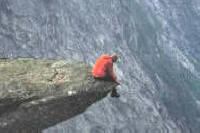Visualisation
 |
I prefer radio to TV because the pictures are better.
|
At some time or other, most people have been disappointed when
they see a film or TV adaptation of a favourite book or radio
programme. The pictures rarely match the mind's eye images of
how places, characters and creatures are visualised.
Here's
another, more easily traced quotation:
Even though it directly stimulates only
your hearing, radio fully engages the other four senses and the
mind. It’s not for the lazy. Unlike TV, movies and even
traditional print, where the pictures are thrust in front of your
eyes, radio forces you to conjure up your own images to accompany
the words you are hearing. As a consequence, those pictures
have more impact because of the effort it takes to create them.
Greg J. Stone, 2016
The link between the level of impact and the cognitive effort required by the listener is the noteworthy part of that.
 |
What's the theory? |
There is good evidence that accessing data in both verbal and visual ways simultaneously enhances learning.
For example, Šmajdek and Selan (2016) report on a study carried out on the effects of visualisation on students’ ability to memorise a difficult written definition. They hypothesised from the outset of the study that
... active visualisation will contribute to
the students’ ability to memorise text in a statistically
significant way. This hypothesis is based on the assumption
that the combination of verbal and visual experiences enhances
cognitive learning.
(Op cit. :163)
and they reported that this hypothesis was confirmed by the experimental data.
 |
A word of caution |
Out here on the web some pretty expansive claims are made for the
power of visualisation including that it can affect our genetic
make-up, make us more attractive to the opposite (or same) sex and
lead to happiness, success and a fulfilling life. Inter
alia, it is claimed that Arnold Schwarzenegger would not have
made a success of three careers without the power of visualisation.
No such claims are being made here. Visualisation here is
presented as an interesting and quite possibly useful classroom
technique. That's all, OK?
 |
Doing visualisation exercises in the classroomNeither feelings nor concepts,
but images are the fundament of human cognition. |
A second word of caution:
Some people find that sitting in a classroom with people you may not
know very well (or much like) with your eyes closed, listening to
someone's voice is not a particularly comfortable experience.
Visualisation should therefore be handled with a little sensitivity.
Explaining its purpose and making it an easy experience, especially
the first time, is very important.
Getting people into a relaxed state of mind before starting is
important, too, and simple deep-breathing exercises can be used for
that.
Visualisation is a practice or awareness-raising technique; it is
not a substitute for teaching language. What is claimed for it
is that it is a powerful aid to memory, an engaging activity and a
way of getting learners to notice language and make it personal.
This site uses images quite extensively (there are five on this page
already and we aren't done yet) and the theory behind that is that people react to images
well and can use them as an aide memoire on which to hang
ideas, concepts and thoughts.
For example, if faced with a number of lexemes in a language you do not speak as your first, you may find it quite difficult to remember what they mean. Adding a picture, the more emotive the better, makes words more memorable. Most teachers are already aware of that and go to some trouble to find engaging visuals to set scenes, exemplify lexis and back up explanations of concepts.
One could, for example, explain the concepts below in words but simply showing the pictures to a class is likely to be more memorable and have greater impact (and it's a good deal quicker, of course):
| homecoming |
 |
daring |
 |
| astonished |
 |
consequences |
 |
| motivation |
 |
drowning |
 |
 |
SoundsClackety-clack |
The value of visualisation is, so the theory goes, that the
hearer has to make his or her own images to match the language
input.
But the input doesn't actually have to be human language.
Here's a little visualisation exercise to practise three different
sorts of things in English (and you can probably think of other
areas to practise). The questions can be altered to accord
with the level of the class and what you want to practise.
| Listening to this clip and imagine. | ||
| To practise tense forms | To practise adjectives of emotion | To practise verbs of perception |
|
|
|
Obviously, learners will be unable to do this until they have
mastered the language forms they need but even before teaching, this
sort of exercise can alert learners to what they need
to know. In that, it's a form of noticing exercise.
The key to this kind of exercise is that it lends itself much more
easily to personalisation and the exchange of thoughts and ideas for
a real communicative purpose. It is interesting in itself to
hear how other people answered the questions and compare that with
your own perceptions.
Everyone will answer the questions differently and how people
respond is almost entirely unpredictable.
 |
Language input to visualisations |
The art of telling a good story or recounting an engaging
anecdote is mostly to do with getting the listeners to visualise
what is being described.
Successful raconteurs use the kinds of language they need to conjure
pictures in their listeners' heads. The best do it naturally;
the rest of us need to try a little harder and that usually means
working from a script.
Here's an example used to practise epistemic modality in the
language of deduction (must be, might do, could be, couldn't be
etc.) and some common perception verbs and adjectives.
Stage 1
Follow this script, speaking as far as possible quite slowly, calmly and clearly. Try not to impose any of your own emotions and emphases.
Close your eyes, breathe slowly in and out and
relax.
[Pause 15 seconds]
You are crossing a road in a small town and walking towards a large,
old-fashioned house. You have a bag in your hand.
[Pause after each question]
What's in the bag?
Is it heavy?
Is there a lot of traffic?
What time of day is it?
What's the weather like?
Are you feeling cold?
Are you feeling relaxed or nervous?
[Pause 5 seconds]
Put your hand in your pocket and find the key.
What does it feel like?
Take it out of your pocket.
What sort of key is it?
What could it open?
Walk up to the front door. Put the key in the lock and turn
it. Open the door.
There is no sound. The house must be empty.
What can you hear?
How does the house smell?
Open the first door on the left and go into the room.
What can you see?
Can you smell anything?
[Pause 5 seconds]
There's a big table in the middle of the room with some objects on
it. They all tell you something about who lives here.
There are:
Two empty cigarette packets
What brand are they?
What does this tell you?
Three detective story books
What's on the front cover?
An English grammar book
Do you know it?
Why is it here?
A pair of reading glasses
What do they tell you?
A laptop computer.
You sit at the table and open the laptop and switch it on. The
screen comes up with a half-written letter. You start to read.
What's the first line?
Who is the letter to?
[Pause 10 seconds]
What do you do now?
You can extend this in any way you like, of course, but for a first time, that's probably enough. It sometimes helps to read the script again to allow people time to gather their thoughts and imagine what they are seeing / hearing / feeling etc. in more detail.
Stage 2
Now:
Put the learners in pairs or small groups of no more than four.
- Task 1:
- The learners compare notes. You can have a short
worksheet for this as an aide memoire with the stages
of the visualisation (road, weather, house, key etc.).
The focus is on how they felt and what things were like.
This stage can take quite a long time and you need to be on hand to help and support the learners with the target language. - Task 2:
- The learners discuss what they found on the table.
With luck, this should involve some of the target modal auxiliary verbs such as:
Whoever lives here must be short sighted
Whoever lives here might be studying English
Whoever lives here must enjoy detective stories
etc.
Here's another, simpler visualisation designed to reinforce learning of household objects and places.
Relax. Close your eyes and breathe
deeply in and out two or three times.
Now you are at home. It is 8 o'clock in the morning.
Go into the kitchen and look around.
What can you see?
Is there a table here?
What's on the table?
Is anyone in the room? Who?
What colour are the walls?
What can you see out of the window?
Leave the room and go to your bedroom. Close the door behind
you.
Look around.
What can you see?
Go to the wardrobe.
What colour is it?
Open the doors.
What is the first thing you see?
Look under the bed.
Is there anything there?
and so on for as many rooms as you like. You can do this
one room at a time over a series of lessons so that the learners
don't get too tired and you can repeat it after you have revised the
vocabulary you are targeting.
Something similar can be used for gardens, towns, holiday locations
and work places. Only your and your learners' imaginations
will limit what you can do.
 |
Get your computer to read it to the class |
You do not have to be particularly tech-savvy to copy this page
into a word processor and get it to read the scripts aloud to the
class. Most decent word processing programs (and Adobe Acrobat
Reader) can do that. They tend to be slightly robotic and
can't handle compound-noun stress but they have the advantage of
being controllable for speed as well as being infinitely and
unchangeably repeatable.
To make it easy for you, you can download both the scripts above as
a single
Word document or
PDF document.
(For more on how to use the screen reader for Microsoft Word, go to
https://support.office.com/en-gb/article/Using-the-Speak-text-to-speech-feature-459e7704-a76d-4fe2-ab48-189d6b83333c.
If you need a free text-to-speech add-in for Word, try http://www.wordtalk.org.uk/Home/.)
Your task is to come up with your own ideas for visualisation exercises and then to teach the lesson.
 |
Personal uses of visualisation |
Visualisation exercises are extensively used in sports training
and other forms of coaching. Athletes and others find that
visualising, e.g., a diving or vaulting manoeuvre, a tennis,
snooker, darts, baseball, cricket or golf shot and so on in detail can help them
perform the action more precisely and effectively in real life.
This ability is enhanced if the player can also envisage where, when
and against whom the manoeuvre takes place.
Sports psychologists know this. Here's what one well-known and
successful sports psychologist (Dr Steve Bull, cited in Bailey,
2014) is reported as saying:
The most important thing with imagery is using multiple senses, like sound, sight and smell. What makes [a player] unique is his imagination. When he visualises scoring a goal, he can feel his foot hitting the ball, the smell of the grass under his foot and the sound of the crowd. This incredibly vivid imagery helps an athlete to prepare mentally, by improving their confidence, focus, clarity and speed of thought. It helps them prepare for any scenario
He goes on:
There is a huge crossover between the demands of sport and business. For example, if you visualise a big business presentation in real detail, you will prepare for everything from your best posture and body language, and how you will handle any feelings of anxiety, to the awkward questions that might be asked and how you will respond to them. By the time you walk in there, you will feel much more confident.
The argument here is that there is no fundamental difference between a business presentation and many other verbal encounters including teaching and using a foreign language. So, there is no reason at all why learners of languages can't employ the same methods to help them perform in language at any level. Speaking is a difficult skill to master and one reason for that is there are three pressures:
- Time
- Preparation level
- Topic familiarity
(See the guide to
understanding speaking for more detail.)
All three of these pressures can be reduced by visualising the
encounter in detail beforehand. It will also help learners to
identify areas where they are not fully prepared so they can do a
little research.
And there's no reason teachers can't use the technique, either.
Being able to visualise events is a skill in itself and comes with practice so learners should not be disappointed if they struggle at first. That's normal and people need to practise doing it. When you try to visualise an event, it helps to have some questions in the front of your mind:
- Where is this event taking place?
- Who are the other participants?
- What will you see?
- What will you hear?
- How will you feel?
- Who will speak first?
- What will that person say?
- What will you say first?
Here are some possible uses:
- Visualising telling a story or anecdote in detail imagining exactly what you will say and what the responses of your listeners will be. This gets the ordering of a story clear in the speaker's mind and reduces the need to use fillers to gain thinking time. It also reduces the stress because the speaker may feel more confident.
- Visualising what happens in an oral examination including the questions one might be asked and the responses one will give. Relaxed, confident learners will perform better.
- Visualising a job interview or an interview for a place at an educational institution.
- As a teacher, visualising all the stages of a lesson or part of a lesson. There's a guide to doing that in the Delta section of this site to prepare for assessment but it can be used for any lesson.
- Visualising a conversation with someone in authority to prepare to sound informed and confident.
- Visualising a commercial transaction: buying, complaining, getting information etc.
- Visualising what you will say in a role play or simulation exercise before being asked to do it.
- Visualising the stages and content of a presentation before delivering it so you can reduce the need for reference to notes and speak seemingly off the cuff. This is important in many EAP and Business English contexts and the same procedures can be used as those set out in the lesson visualisation guide (link above).
You can probably think of some more.
| Links | |
| the Delta section | for the guide to using visualisation to prepare for teaching |
| understanding speaking | for a guide to what makes it so difficult |
| speaking for EAP | this guide is focused partly on giving a presentation and includes consideration of using visualisation to prepare |
| Word document or PDF document | for the visualisation scripts |
References:
Bailey, M, 2014, Sports
visualisation: how to imagine your way to success, The Daily
Telegraph, 22 Jan 2014 [available online (or was)]
Šmajdek, A and Selan, J, 2016, The
Impact of Active Visualisation of High School Students on the
Ability to Memorise Verbal Definitions, University of
Ljubljana, Slovenia, Centre for Educational Policy Studies Journal |
Vol.6 | No4 | pp. 163 - 186
Stone, G J, 2016, The Pictures Are Better on Radio, http://www.huffingtonpost.com/greg-j-stone/the-pictures-are-better-o_b_12074406.html
[accessed July 2017]
